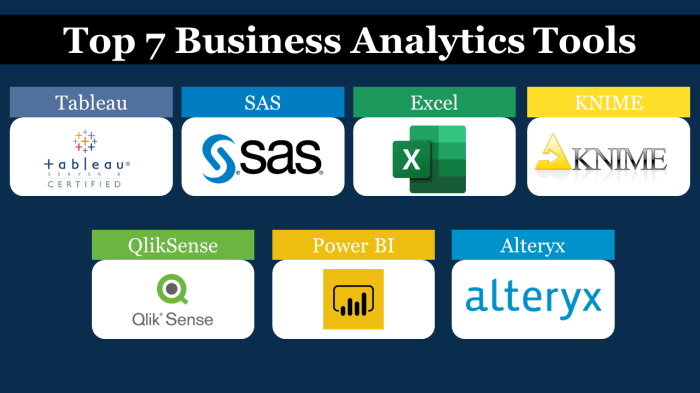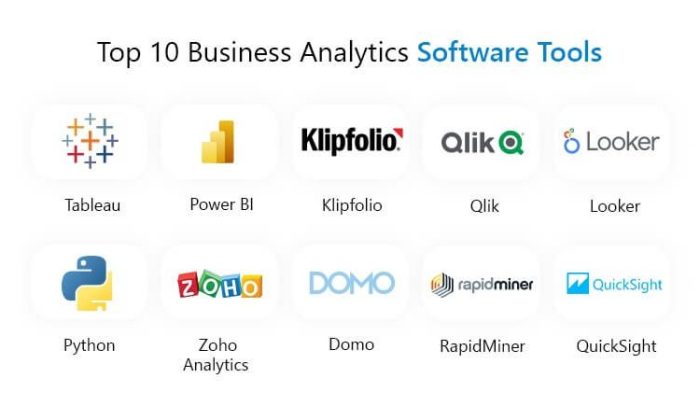Diving into the realm of business analytics tools, we uncover their pivotal role in driving data-driven decisions within today’s enterprises. From aiding in decision-making to offering insights, these tools are revolutionizing the business landscape.
As we delve deeper, we explore the significance of these tools, their common features, implementation strategies, and the latest trends reshaping the industry.
Overview of Business Analytics Tools
In the fast-paced world of modern enterprises, utilizing business analytics tools is crucial for success. These tools help organizations make informed decisions based on data-driven insights, ultimately leading to improved performance and profitability.
Types of Business Analytics Tools
There are various types of business analytics tools available in the market, each serving a specific purpose in analyzing and interpreting data. Some of the common types include:
- Predictive Analytics Tools: These tools use historical data and statistical algorithms to forecast future trends and outcomes, helping organizations anticipate and plan for potential scenarios.
- Descriptive Analytics Tools: This type of tool focuses on summarizing and interpreting past data to provide insights into what has happened in the past, giving a clear picture of the current state of the business.
- Prescriptive Analytics Tools: These tools not only analyze data but also recommend the best course of action to achieve specific outcomes, providing valuable guidance for decision-making processes.
Common Features of Business Analytics Tools

Business analytics tools come with a variety of features that help businesses make informed decisions based on data analysis. These tools are essential for gaining insights into trends, patterns, and performance metrics to drive strategic planning and improve overall efficiency.
Data Visualization
Data visualization is a key feature of business analytics tools that allows users to create interactive charts, graphs, and dashboards to represent complex data in a visual format. This feature enables stakeholders to easily interpret data and identify trends or outliers at a glance.
- Examples of data visualization tools include Tableau, Power BI, and QlikView.
- Benefits: Data visualization helps businesses communicate insights effectively, make faster decisions, and identify areas for improvement.
Predictive Analytics
Predictive analytics is a feature that uses statistical algorithms and machine learning techniques to forecast future trends or outcomes based on historical data. This feature enables businesses to anticipate customer behavior, market trends, and potential risks.
- Examples of predictive analytics tools include IBM SPSS, SAS, and RapidMiner.
- Benefits: Predictive analytics helps businesses optimize operations, improve forecasting accuracy, and mitigate risks proactively.
Reporting and Dashboards
Reporting and dashboards allow users to generate customized reports and real-time dashboards to monitor key performance indicators (KPIs) and track progress towards business goals. This feature provides stakeholders with actionable insights to drive data-driven decision-making.
- Examples of reporting and dashboard tools include Google Data Studio, Microsoft Excel, and Domo.
- Benefits: Reporting and dashboards help businesses track performance metrics, identify areas of improvement, and measure the impact of strategic initiatives.
Implementation of Business Analytics Tools

Implementing business analytics tools within an organization involves several key steps to ensure successful deployment and adoption. Companies may face challenges during the integration process, but with best practices in place, they can overcome these obstacles and fully leverage the power of analytics tools.
Steps in Implementing Business Analytics Tools
- Assessing Organizational Needs: Identify the specific goals and objectives that the analytics tools will help achieve.
- Choosing the Right Tools: Select tools that align with the organization’s needs and capabilities.
- Data Collection and Integration: Gather relevant data from various sources and integrate it into the analytics platform.
- Training and Education: Provide training to employees to ensure they can effectively use the analytics tools.
- Testing and Evaluation: Conduct thorough testing to ensure the tools are working correctly and meeting the desired outcomes.
- Deployment and Monitoring: Roll out the analytics tools across the organization and continuously monitor their performance.
Challenges in Integrating Business Analytics Tools
- Data Quality Issues: Ensuring the accuracy and reliability of data being used for analysis can be a major challenge.
- Cultural Resistance: Employees may resist using analytics tools if they perceive them as a threat to their jobs or traditional ways of working.
- Integration with Existing Systems: Compatibility issues with existing IT infrastructure can hinder the seamless integration of analytics tools.
Best Practices for Successful Deployment and Adoption
- Executive Buy-In: Secure support from top management to drive the adoption of analytics tools throughout the organization.
- Change Management: Implement effective change management strategies to help employees transition to using analytics tools.
- Continuous Training: Provide ongoing training and support to ensure employees are comfortable with using the tools.
- Data Governance: Establish clear data governance policies to maintain data quality and security.
Trends in Business Analytics Tools
In today’s rapidly evolving business landscape, staying updated with the latest trends in business analytics tools is crucial for organizations looking to gain a competitive edge. Let’s dive into the key trends shaping the future of these tools.
AI and Machine Learning Integration
With the advancements in artificial intelligence (AI) and machine learning, business analytics tools are becoming more sophisticated and powerful than ever. These technologies enable tools to analyze vast amounts of data quickly and accurately, providing valuable insights for decision-making. From predictive analytics to automated data processing, AI and machine learning are revolutionizing how businesses leverage data to drive growth and innovation.
Cloud-Based Solutions for Accessibility and Scalability
The shift towards cloud-based solutions has significantly impacted the accessibility and scalability of business analytics tools. Cloud platforms offer businesses the flexibility to access analytics tools from anywhere, at any time, leading to improved collaboration and real-time decision-making. Moreover, cloud-based solutions eliminate the need for costly hardware infrastructure, making advanced analytics capabilities more affordable and scalable for organizations of all sizes.